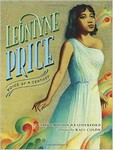Through the Looking Glass Children's Book Reviews
Leontyne Price: Voice of a century
Illustrator: Raul Colon
Nonfiction Picture Book
For ages 5 to 7
Random House, 2015
When Leontyne Price was growing up in Laurel Mississippi in the 1920’s, the gap between white and black people “was as wide as the Mississippi River was long.” Opportunities for African Americans were few and life was hard, and yet Leontyne was lucky because her life was enriched by the love of her parents and by the music that filled her life. Leontyne’s father played the tuba in the church band and her mother sang hymns.
While she was still very young, Leontyne began to discover that she too had a voice, a gift for music. She listened to the Metropolitan Opera radio broadcasts on Saturday afternoons and fell in love with the rich and glorious arias that she heard. Seeing her love for music, Leontyne’s parents sold their phonograph, bought a piano and arranged for her to have lessons.
Then Leontyne saw Marian Anderson perform, and the great singer’s song “like a torch, sparked a light in Leontyne.” A college president recognized this light for what it was when he heard Leontyn sing. He was so impressed that he persuaded Leontyne to study voice instead of studying to become a teacher. Following in the footsteps of Marian Anderson, Leontyne set out to become a professional singer. She went to Juilliard and performed in Porgy and Bess on Broadway. From there she went on to perform in an opera and became the first black singer to sing on the stage at La Scala, one of the most famous opera venues in the world.
This inspirational picture book tells the story of one of America’s great opera singers, who “blew open the door that Marian left ajar.” She paved the way for many wonderful African American singers who came after her, and showed the world that talent and the gift for creating beautiful music is color blind.
Throughout the book the powerful text is paired with Raul Colon’s colorful and expressive artwork. At the back of the book an author’s note provides readers with further information about Leontyne’s life and achievements.



